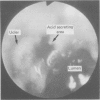Abstract
Multiple pinch biopsies were taken from the duodenum and antrum of 137 subjects (46 active duodenal ulceration; 44 healed ulcers; 47 'normal'), and examined for the presence and grade of gastritis, gastric metaplasia, and Campylobacter pylori. These factors, as well as age, sex, cigarette, and anti-inflammatory agent intake were evaluated as possible risk factors for duodenal ulceration. Pentagastrin induced Congo Red staining of the duodenal bulb was performed in an additional 43 cases, to determine the presence of functioning parietal cells in the duodenum. Ninety eight per cent of patients with duodenal infection with C pylori had active or healed duodenal ulcers. Bacteria were confined to areas of gastric metaplasia which was always infiltrated with inflammatory cells. The metaplastic tissue was usually superficial in type, although patients had C pylori associated with heterotopic tissue: this has not been previously described. Congo Red staining of the duodenal bulb showed that functioning endogenous acid producing tissue could be found most often at the edges of duodenal ulcers, but also in non-ulcer subjects. Cigarette smoking, age, sex, and ingestion of non-steroidal anti-inflammatory agents were not to be found to be significant risk factors for duodenal ulceration. In contrast, the presence of duodenal infection with C pylori proved to be a strong risk factor for duodenal ulceration (RR = 51), together with gastric metaplasia (RR = 6.2), and antral C pylori infection (RR = 7.6). These data identify duodenal infection with C pylori as the strongest risk factor for development of duodenal ulceration. Our finding of endogenous acid production around the edges of duodenal ulcers suggests an active role for parietal cells in the duodenum. We postulate a synergistic role for duodenal C pylori and endogenous acid production in the development of duodenal ulceration.
Full text
PDF







Images in this article
Selected References
These references are in PubMed. This may not be the complete list of references from this article.
- Bendtsen F., Rosenkilde-Gram B., Tage-Jensen U., Ovesen L., Rune S. J. Duodenal bulb acidity in patients with duodenal ulcer. Gastroenterology. 1987 Dec;93(6):1263–1269. doi: 10.1016/0016-5085(87)90254-x. [DOI] [PubMed] [Google Scholar]
- Cortot A., Henry-Amar M., Pappo M., Paris J. C. Efficacité comparée de la ranitidine (150 mg X 2) et de la cimétidine (400 mg X 2) dans le traitement de l'ulcère duodénal en poussée. Essai thérapeutique contrôlé multicentrique français. Gastroenterol Clin Biol. 1987 Feb;11(2):136–141. [PubMed] [Google Scholar]
- Donahue P. E., Bombeck C. T., Yoshida J., Nyhus L. M. The simplified endoscopic Congo Red test for completeness of vagotomy. Surg Gynecol Obstet. 1986 Sep;163(3):287–289. [PubMed] [Google Scholar]
- Floch M. H. Campylobacter pyloridis: identification and clinical significance. Am J Gastroenterol. 1987 Apr;82(4):358–358. [PubMed] [Google Scholar]
- Hazell S. L., Hennessy W. B., Borody T. J., Carrick J., Ralston M., Brady L., Lee A. Campylobacter pyloridis gastritis II: Distribution of bacteria and associated inflammation in the gastroduodenal environment. Am J Gastroenterol. 1987 Apr;82(4):297–301. [PubMed] [Google Scholar]
- Hazell S. L., Lee A. Campylobacter pyloridis, urease, hydrogen ion back diffusion, and gastric ulcers. Lancet. 1986 Jul 5;2(8497):15–17. doi: 10.1016/s0140-6736(86)92561-4. [DOI] [PubMed] [Google Scholar]
- Ikeda K., Sannohe Y., Murayama H., Ikeda R., Inutsuka S. Heterotopic gastric mucosa in the duodenum - reaction to Congo red under fiberscopic observation. Endoscopy. 1982 Sep;14(5):168–170. doi: 10.1055/s-2007-1021611. [DOI] [PubMed] [Google Scholar]
- JAMES A. H. GASTRIC EPITHELIUM IN THE DUODENUM. Gut. 1964 Aug;5:285–294. doi: 10.1136/gut.5.4.285. [DOI] [PMC free article] [PubMed] [Google Scholar]
- Johansen A., Hansen O. H. Heterotopic gastric epithelium in the duodenum and its correlation to gastric disease and acid level. Acta Pathol Microbiol Scand A. 1973 Sep;81(5):676–680. doi: 10.1111/j.1699-0463.1973.tb03560.x. [DOI] [PubMed] [Google Scholar]
- Kreuning J., Bosman F. T., Kuiper G., Wal A. M., Lindeman J. Gastric and duodenal mucosa in 'healthy' individuals. An endoscopic and histopathological study of 50 volunteers. J Clin Pathol. 1978 Jan;31(1):69–77. doi: 10.1136/jcp.31.1.69. [DOI] [PMC free article] [PubMed] [Google Scholar]
- Marshall B. J. Peptic ulcer: an infectious disease? Hosp Pract (Off Ed) 1987 Aug 15;22(8):87–96. doi: 10.1080/21548331.1987.11703288. [DOI] [PubMed] [Google Scholar]
- Morris A., Nicholson G. Ingestion of Campylobacter pyloridis causes gastritis and raised fasting gastric pH. Am J Gastroenterol. 1987 Mar;82(3):192–199. [PubMed] [Google Scholar]
- Patrick W. J., Denham D., Forrest A. P. Mucous change in the human duodenum: a light and electron microscopic study and correlation with disease and gastric acid secretion. Gut. 1974 Oct;15(10):767–776. doi: 10.1136/gut.15.10.767. [DOI] [PMC free article] [PubMed] [Google Scholar]
- Perera D. R., Weinstein W. M., Rubin C. E. Symposium on pathology of the gastrointestinal tract-Part II. Small intestinal biopsy. Hum Pathol. 1975 Mar;6(2):157–217. doi: 10.1016/s0046-8177(75)80176-6. [DOI] [PubMed] [Google Scholar]
- Steer H. W. Surface morphology of the gastroduodenal mucosa in duodenal ulceration. Gut. 1984 Nov;25(11):1203–1210. doi: 10.1136/gut.25.11.1203. [DOI] [PMC free article] [PubMed] [Google Scholar]
- Tanemura H., Uno S., Suzuki M., Miyauchi Y., Shimokawa K., Saji S., Ohashi H., Sakata K. Heterotopic gastric mucosa accompanied by aberrant pancreas in the duodenum. Am J Gastroenterol. 1987 Jul;82(7):685–688. [PubMed] [Google Scholar]
- Tominaga K. Distribution of parietal cells in the antral mucosa of human stomachs. Gastroenterology. 1975 Dec;69(6):1201–1207. [PubMed] [Google Scholar]
- Willis R. A. Some unusual developmental heterotopias. Br Med J. 1968 Aug 3;3(5613):267–272. doi: 10.1136/bmj.3.5613.267. [DOI] [PMC free article] [PubMed] [Google Scholar]
- Wolff M. Heterotopic gastric epithelium in the rectum: a report of three new cases with a review of 87 cases of gastric heterotopia in the alimentary canal. Am J Clin Pathol. 1971 May;55(5):604–616. doi: 10.1093/ajcp/55.5.604. [DOI] [PubMed] [Google Scholar]
- Wyatt J. I., Rathbone B. J., Dixon M. F., Heatley R. V., Axon A. T. Campylobacter pylori and development of duodenal ulcer. Lancet. 1988 Jan 16;1(8577):118–119. doi: 10.1016/s0140-6736(88)90315-7. [DOI] [PubMed] [Google Scholar]
- Wyatt J. I., Rathbone B. J., Dixon M. F., Heatley R. V. Campylobacter pyloridis and acid induced gastric metaplasia in the pathogenesis of duodenitis. J Clin Pathol. 1987 Aug;40(8):841–848. doi: 10.1136/jcp.40.8.841. [DOI] [PMC free article] [PubMed] [Google Scholar]




